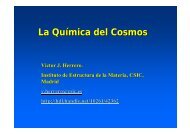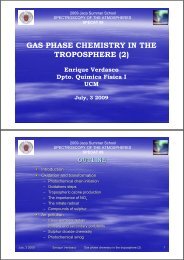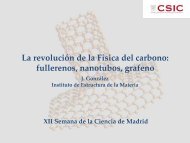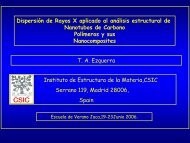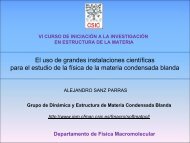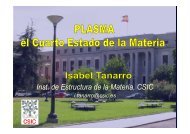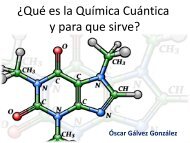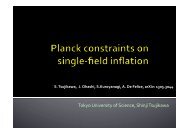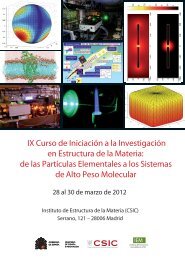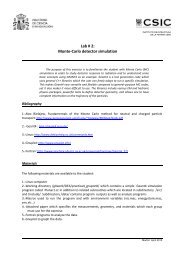2B.1 THEORETICAL PHYSICS AND CHEMISTRY DEPARTMENTRESEARCH LINES:‣ Gravitation and Cosmology.‣ Con<strong>de</strong>nsed Matter Theory.‣ Theoretical Nuclear Physics: Structure and Reactions.‣ Theoretical Physical-Chemistry applied to Astrophysics.RESEARCH SUBLINES:C<strong>la</strong>ssical and Quantum General Re<strong>la</strong>tivity.Quantum Cosmology.Loop Quantum Gravity.B<strong>la</strong>ck hole physics.Computational methods in gravitational physics.Strongly corre<strong>la</strong>ted and mesoscopic systems.Electroweak processes in nuclei.Nuclear Structure from a selfconsistent corre<strong>la</strong>ted mean field approach.Three-body techniques in Nuclear Physics.Reactions of relevance in Nuclear Astrophysics.Ine<strong>la</strong>stic non-reactive collisions at low temperatures.Theoretical spectroscopy of molecu<strong>la</strong>r species relevant for astrophysics and atmosphere.EMPLOYED TECHNIQUES:oooooooTheoretical and mathematical physics.Computational methods.Renormalization group.Selfconsistent mean field calcu<strong>la</strong>tion techniques.Numerical methods to solve the Fad<strong>de</strong>ev equations in coordinate space.Hyperspherical Adiabatic Expansion Method.High level ab initio calcu<strong>la</strong>tions.RESEARCH ACTIVITY:QUANTUM GRAVITY& QUANTUM COSMOLOGYDuring the year <strong>2011</strong> we have carried to completion the work that we had been <strong>de</strong>veloping in the <strong>la</strong>st years on thestudy of b<strong>la</strong>ck hole entropy in loop quantum gravity (LQG). Specifically we have been able to finish the study of theasymptotic behavior of the entropy as a function of the horizon area. The most important open problem in thisregard was to <strong>de</strong>termine if the intriguing structure observed for low areas was also present in the asymptotic regime.To accomplish this goal, during 2010 we <strong>de</strong>veloped a number of statistical methods that led to an efficientapproximation procedure for the statistical entropy that clearly exp<strong>la</strong>ined why the low area substructure had todisappear at <strong>la</strong>rge scales. The result that we have just <strong>de</strong>scribed can be un<strong>de</strong>rstood, from a completely differentperspective, if we rely on the formalism of statistical mechanics and, in particu<strong>la</strong>r, on some aspects re<strong>la</strong>ted to itsmathematical foundations. In this context it is of basic importance to un<strong>de</strong>rstand the mathematical properties of theentropy as a function of the energy (the relevant variable in standard statistical mechanics). It is very important, forexample, to <strong>de</strong>termine un<strong>de</strong>r which conditions the entropy is a sufficiently smooth function of the energy and itsconvexity properties. The first point is relevant because thermodynamical properties (such as the temperature of agiven system) are <strong>de</strong>fined as <strong>de</strong>rivatives of the entropy, whereas the second is central to the un<strong>de</strong>rstanding of thestability of physical systems. The c<strong>la</strong>ssical theorems on these issues prove that in the so called thermodynamic limitthe entropy satisfies reasonable smoothness and convexity properties.During the <strong>la</strong>st year we have <strong>de</strong>voted a consi<strong>de</strong>rable effort to un<strong>de</strong>rstand the thermodynamic limit for b<strong>la</strong>ck holes byusing the combinatorial methods that we have <strong>de</strong>veloped in the preceding years. As in the case of interest for us it ispossible to effectively build both the microcanonical and the canonical (area) ensembles, we have been able to studythe behavior of b<strong>la</strong>ck holes in the thermodynamic limit (not to be confused with the <strong>la</strong>rge area limit). The mostimportant conclusion of our work is that, in this limit, the entropy is in<strong>de</strong>ed a smooth and concave function of thearea and it also satisfies the Bekenstein-Hawking <strong>la</strong>w. It is important to highlight, nonetheless, the fact that48
subdominant corrections (proportional to the logarithm of the area) are different for the statistical (counting) entropyand the true thermodynamical entropy. This fact is relevant not only within the context of LQG but also for otherapproaches to quantum gravity such as string theories.The methods of LQG have also been employed to analyze the quantum realm in cosmological systems, in the fieldof specialization that is nowadays known as loop quantum cosmology (LQC). In particu<strong>la</strong>r, during <strong>2011</strong> we haveimplemented and compared the so-called improved dynamics prescriptionsthat exist for LQC in the literature,studying homogeneous and isotropic spacetimes containing a massless sca<strong>la</strong>r field. We have checked that all theseprescriptions lead to the same qualitative results for semic<strong>la</strong>ssical states in such cosmological spacetimes, and thatthe physical behavior is in fact simi<strong>la</strong>r even for states which are not so semic<strong>la</strong>ssical or in regimes where thequantum effects start to be not totally negligible, although there exist discrepancies. What is more important, not allof these prescriptions have the same properties from the viewpoint of numerical computations. In particu<strong>la</strong>r, aprescription introduced by us seems especially simple to implement and reduces consi<strong>de</strong>rably the time ofcomputation. We have optimized the co<strong>de</strong>s of our numerical library for simu<strong>la</strong>tions in LQC in or<strong>de</strong>r to take ful<strong>la</strong>dvantage of the features of this specific prescription.During this year we have also successfully applied loop techniques to inhomogeneous cosmologies of the Gowdytype including a masless sca<strong>la</strong>r field, reaching for the first time a complete and consistent quantization in theframework of LQC for a mo<strong>de</strong>l with local <strong>de</strong>grees of freedom in the matter content and in the geometry. We have<strong>de</strong>veloped a proposal for a hybrid quantization of this mo<strong>de</strong>l, and implemented it to completion, proving theconsistency of the approach.The aim of this work has been manifold: a) to obtain an exact quantum <strong>de</strong>scription ofinhomogeneous cosmologies with matter fields that inclu<strong>de</strong>s effects of the loop quantum geometry, b) to <strong>de</strong>terminethe space of physical states and a complete set of physical observables, c) to prove that the quantum dynamics iswell posed, d) to <strong>de</strong>monstrate that the cosmological singu<strong>la</strong>rities are resolved in this framework, and e) to show thatone recovers the standard Fock quantization for the inhomogeneities in appropriate regimes for physical states.Moreover, restricting the analysis to the vacuum case, we have also discussed the effect of the inhomogeneities onthe Big Bounce that rep<strong>la</strong>ces the Big Bang singu<strong>la</strong>rity, using the effective theory associated with our exact quantummo<strong>de</strong>l. The analytical study has confirmed the qualitative robustness of the bounce. Numerical simu<strong>la</strong>tions haveshown that this robustness is also quantitative. Besi<strong>de</strong>s, this numerical analysis has <strong>de</strong>monstrated that the amplitu<strong>de</strong>sof the inhomogeneities do not change statistically in the bouncing process, except when they are small, case inwhich they seem to be en<strong>la</strong>rged by a kind of enhancing mechanism. This mechanism might exp<strong>la</strong>in the re<strong>la</strong>tively<strong>la</strong>rge amplitu<strong>de</strong> of primordial fluctuations if it is confirmed in more realistic cosmological mo<strong>de</strong>ls.In field like systems like this, which possess an infinite number of <strong>de</strong>grees of freedom, a severe problem are theambiguities found in the quantization process, which affect the final outcome in the quantum theory. In the case of aFock quantization, where one can reach a concept of particle for the field (at least to a certain extent), an importantpart of these ambiguities are those arising in the choice of a quantum representation. This problem is encountered instandard quantum field theory on curved backgrounds, but also in the case of the quantization of theinhomogeneities within the hybrid scheme put forward by us in the framework of LQC. In stationary settings,symmetry or energy criteria are known to select a unique Fock quantization. Quite remarkably, we have been able toprove recently that, even in non-stationary settings, one can pick up a unique Fock quantization by introducing thecriteria of a) invariance of the vacuum un<strong>de</strong>r the symmetries of the field equations, and b) unitarity in the dynamicalevolution (with respect to an emergent time re<strong>la</strong>ted to area or volume elements). This uniqueness provi<strong>de</strong>s aconsi<strong>de</strong>rable robustness to the results of the quantization and its physical predictions. Strictly speaking, theuniqueness theorems reached so far apply to the case of sca<strong>la</strong>r fields on any compact spatial topology and in anyspatial dimension equal or smaller than three. Applications for an unambiguous quantization of perturbations incosmology are almost direct.Another research line that we have followed has been the analysis of Hawking radiation in a Schwarzschild b<strong>la</strong>ckhole as perceived by different observers. The method is based on the introduction of an effective temperaturefunction that varies with time. First we introduce a non-stationary vacuum state which mimics the process ofswitching on Hawking radiation in a stationary spacetime. Then, we analyse this vacuum state from the perspectiveof static observers at different radial positions, observers un<strong>de</strong>rgoing a free-fall trajectory from infinity, andobservers standing at rest at a radial distance and then released to fall freely towards the horizon. We find thatgeneric freely-falling observes do not perceive vacuum when crossing the horizon, but an effective temperature afew times <strong>la</strong>rger than the one that they perceived when started to free-fall. We exp<strong>la</strong>in this phenomenon as due to adiverging Doppler effect at horizon crossing. From a different perspective, we use the trans-P<strong>la</strong>nckian problem ofHawking radiation as a guiding principle in searching for a compelling scenario for the evaporation of b<strong>la</strong>ck holes orb<strong>la</strong>ck-hole-like objects. We argue that there exist only three possible scenarios, <strong>de</strong>pending on whether the c<strong>la</strong>ssicalnotion of long-lived horizon is preserved by high-energy physics and on whether the dark and compact astrophysicalobjects that we observe have long-lived horizons in the first p<strong>la</strong>ce. Along the way, we find that a) a theory withhigh-energy superluminar signalling and a long-lived trapping horizon would be extremely unstable in astrophysical49
- Page 3: INTRODUCCIÓNEl Instituto de Estruc
- Page 10 and 11: Dra. Maria Esperanza Cagiao Escohot
- Page 12 and 13: TALLER ÓPTICOD. José Lasvignes Pa
- Page 14 and 15: 2A.1 DPTO. DEQUÍMICA YFÍSICA TEÓ
- Page 16: empezar a caer. Este fenómeno se e
- Page 19 and 20: Existen varias diferencias entre la
- Page 21 and 22: Estudio de las propiedades estructu
- Page 23 and 24: poblar los estados de interés en 1
- Page 25 and 26: Si bien la técnica TF está bien e
- Page 27 and 28: que no se produzca la ruptura de en
- Page 30 and 31: antitumoral emodina mediante el efe
- Page 32 and 33: Esta formulación ha sido desarroll
- Page 34 and 35: oooooCriogenia.Espectroscopía Rama
- Page 36 and 37: FLUIDODINÁMICA MOLECULAREl princip
- Page 38 and 39: También se ha concluido y publicad
- Page 40 and 41: o Análisis mecánico en tracción:
- Page 42 and 43: cuerpo (BCC), tiene lugar la formac
- Page 44 and 45: BIOSAXSCaracterización de coloides
- Page 46 and 47: Sin embargo, desde el punto de vist
- Page 50 and 51: terms and that b) stellar pulsation
- Page 52 and 53: We have investigated transport thro
- Page 54 and 55: een proposed as possible interstell
- Page 56 and 57: The figure shows a compilation of t
- Page 58 and 59: oppositely aligned spins. This pair
- Page 60 and 61: PHYSICAL BEHAVIOR AT NANO-SCALESPro
- Page 62 and 63: done in collaboration with research
- Page 64 and 65: Finally, we have also conducted a w
- Page 66 and 67: species have been obtained from tim
- Page 68 and 69: Rideal mechanism, with a preference
- Page 70 and 71: Liquid hydrogen filament (5 micron
- Page 72 and 73: Nanostructure of polymer thin films
- Page 74 and 75: morphological model for Natural Rub
- Page 76 and 77: product. The clay can be used direc
- Page 78 and 79: with the extracellular ERBBs domain
- Page 80 and 81: 3.1 DPTO. DEQUÍMICA YFÍSICA TEÓR
- Page 82 and 83: Duration: January 2010-December 201
- Page 84 and 85: Objectives: This Project aims at ob
- Page 86 and 87: Funding Institution: Comunidad de M
- Page 89 and 90: CAPÍTULO 4COOPERACIÓN CIENTÍFICA
- Page 91 and 92: 4.1.3 DPTO. DE FÍSICA MOLECULAR /
- Page 93 and 94: o Complete Hybrid Quantization of a
- Page 95 and 96: R3B Collaboration Meeting, Darmstad
- Page 97 and 98: SERS Roundtable 2011, Poltersdorf (
- Page 99 and 100:
International Conference on Process
- Page 101 and 102:
4.3. ESTANCIAS DE INVESTIGADORES EN
- Page 103 and 104:
Dr. Francesca Vidotto.Université d
- Page 105 and 106:
4.4.3 DPTO. DE FÍSICA MOLECULAR /
- Page 107:
Guillermo Ribeiro Jiménez. Subatom
- Page 110 and 111:
5.1 DOCENCIA / TEACHING5.1.1 DPTO.
- Page 112 and 113:
5.1.3 DPTO. DE FÍSICA MOLECULAR /
- Page 114 and 115:
5.2.3 DPTO. DE FÍSICA MOLECULAR /
- Page 116 and 117:
Óscar Gálvezo Hielos y Plasmas de
- Page 118 and 119:
Olof Tengblad- Deputy Technical Man
- Page 120 and 121:
5.5 ACTIVIDADES Y MATERIAL DE DIVUL
- Page 122 and 123:
Plasma, el cuarto estado de la mate
- Page 124 and 125:
5.7 UNIDADES ASOCIADAS Y OTRAS ACTI
- Page 126 and 127:
oScientific collaboration on “Din
- Page 128 and 129:
6.1 PUBLICACIONES EN REVISTAS Y PRO
- Page 130 and 131:
Prescriptions in Loop Quantum Cosmo
- Page 132 and 133:
Richardson-Gaudin Models: The Hyper
- Page 134 and 135:
79. L. Guerrini, S. Sanchez-Cortes,
- Page 136 and 137:
Probing the Nature of Particle-Core
- Page 138 and 139:
PROCEEDINGS ISI /ISI PROCEEDINGS120
- Page 140 and 141:
Physical Review Letters 106, 245301
- Page 142 and 143:
Conducting Nanocomposites Based on
- Page 144 and 145:
3. O. S. Kirsebom, S. Hyldegaard, M
- Page 146 and 147:
6.4 TESIS DOCTORALES / Ph. D. THESE
- Page 149 and 150:
CAPÍTULO 7TABLAS Y DATOSCHAPTER 7T
- Page 151 and 152:
Spectrochimica Acta B 2 3.552Chemph
- Page 153 and 154:
7.4 PERSONAL POR DEPARTAMENTOS /PER
- Page 155 and 156:
ÍNDICEINDEX155
- Page 157 and 158:
4.1.2 Dpto. de Espectroscopía Nucl
- Page 159:
6.2.2 Dpto. de Espectroscopía Nucl




